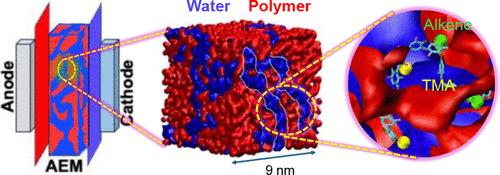当前位置:
X-MOL 学术
›
J. Phys. Chem. C
›
论文详情
Our official English website, www.x-mol.net, welcomes your feedback! (Note: you will need to create a separate account there.)
Degradation of Anion Exchange Membranes by Cation Elimination: Impact on Water Uptake, Nanostructure, and Ionic Mobility
The Journal of Physical Chemistry C ( IF 3.3 ) Pub Date : 2024-06-18 , DOI: 10.1021/acs.jpcc.4c02639 Shakkira Erimban 1 , Ignacio J. Bombau 1, 2 , John J. Karnes 3 , Valeria Molinero 1
The Journal of Physical Chemistry C ( IF 3.3 ) Pub Date : 2024-06-18 , DOI: 10.1021/acs.jpcc.4c02639 Shakkira Erimban 1 , Ignacio J. Bombau 1, 2 , John J. Karnes 3 , Valeria Molinero 1
Affiliation

|
Anion exchange membranes (AEMs) are an attractive platform for fuel cell and electrolysis technologies since they enable the use of cheaper, nonplatinum group metal electrodes and components. However, the widespread adoption of AEM-based devices is limited by chemical degradation of the AEM in the highly alkaline medium of operation. Experimental studies report three major pathways of degradation, including substitution (SN2), elimination (E2), and backbone cleavage. The decline in membrane performance is likely due to a cumulative effect of several pathways, which has proven to be difficult to disentangle through experiments. Here we use coarse-grained molecular simulations to isolate the impact of E2 degradation, where cationic sites are replaced by an alkene group, on AEM water uptake, nanoscale morphology, structure of the ion-conducting channels, water mobility, and ionic conductivity. Our studies focus on the well-studied model AEM polyphenylene oxide with tetraalkylammonium cationic sites (PPO-TMA). We find that about half of the hydrophobic groups resulting from the degradation retract into the hydrophobic domains of the membrane. The reduction in ion exchange capacity (IEC) and the hydrophobicity of the alkene groups decrease both the equilibrium water uptake (%WU) and the number of water molecules per cation (λ) of the membrane. Interestingly, the evolution of λ with the IEC seems to follow that of undegraded PPO-TMA membranes. We ascribe this to the similarity between the structure of the degraded monomer and the neutral one in the polymer. We conclude that most of the performance losses originate in the lower hydration of the degraded membrane.
中文翻译:

阴离子交换膜因阳离子消除而降解:对水吸收、纳米结构和离子迁移率的影响
阴离子交换膜 (AEM) 是燃料电池和电解技术的一个有吸引力的平台,因为它们可以使用更便宜的非铂族金属电极和组件。然而,基于 AEM 的设备的广泛采用受到 AEM 在高碱性工作介质中化学降解的限制。实验研究报告了三种主要的降解途径,包括取代 (S N 2)、消除 (E2) 和主链裂解。膜性能的下降可能是由于多种途径的累积效应造成的,这已被证明很难通过实验来理清。在这里,我们使用粗粒度分子模拟来隔离 E2 降解(其中阳离子位点被烯烃基团取代)对 AEM 吸水量、纳米级形态、离子传导通道结构、水迁移率和离子电导率的影响。我们的研究重点是经过充分研究的具有四烷基铵阳离子位点的 AEM 聚苯醚模型 (PPO-TMA)。我们发现大约一半的降解产生的疏水基团缩回到膜的疏水域中。离子交换容量 (IEC) 的降低和烯烃基团的疏水性降低了膜的平衡吸水量 (%WU) 和每个阳离子的水分子数 (λ)。有趣的是,IEC 的 λ 演变似乎遵循未降解的 PPO-TMA 膜的演变。我们将此归因于降解单体与聚合物中中性单体结构的相似性。我们得出的结论是,大部分性能损失源于降解膜的较低水合作用。
更新日期:2024-06-18
中文翻译:

阴离子交换膜因阳离子消除而降解:对水吸收、纳米结构和离子迁移率的影响
阴离子交换膜 (AEM) 是燃料电池和电解技术的一个有吸引力的平台,因为它们可以使用更便宜的非铂族金属电极和组件。然而,基于 AEM 的设备的广泛采用受到 AEM 在高碱性工作介质中化学降解的限制。实验研究报告了三种主要的降解途径,包括取代 (S N 2)、消除 (E2) 和主链裂解。膜性能的下降可能是由于多种途径的累积效应造成的,这已被证明很难通过实验来理清。在这里,我们使用粗粒度分子模拟来隔离 E2 降解(其中阳离子位点被烯烃基团取代)对 AEM 吸水量、纳米级形态、离子传导通道结构、水迁移率和离子电导率的影响。我们的研究重点是经过充分研究的具有四烷基铵阳离子位点的 AEM 聚苯醚模型 (PPO-TMA)。我们发现大约一半的降解产生的疏水基团缩回到膜的疏水域中。离子交换容量 (IEC) 的降低和烯烃基团的疏水性降低了膜的平衡吸水量 (%WU) 和每个阳离子的水分子数 (λ)。有趣的是,IEC 的 λ 演变似乎遵循未降解的 PPO-TMA 膜的演变。我们将此归因于降解单体与聚合物中中性单体结构的相似性。我们得出的结论是,大部分性能损失源于降解膜的较低水合作用。











































 京公网安备 11010802027423号
京公网安备 11010802027423号